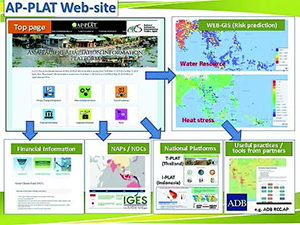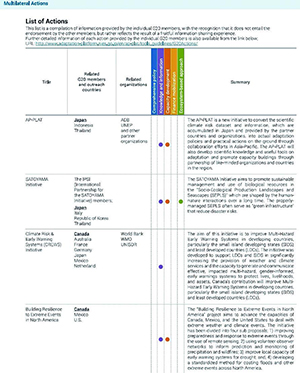Feature
Launch of the AP-PLAT and Compilation of the Adaptation Action Agenda
.jpg)
Launching ceremony of AP-PLAT at the G20 Karuizawa meeting (16 June 2019)

AP-PLAT website
Launch of the Asia-Pacific Adaptation Information Platform (AP-PLAT)
At the UNFCCC COP22 in 2016, the Ministry of the Environment expressed its intent to establish the “Asia-Pacific Adaptation Information Platform (AP-PLAT)” by 2020 to provide information and datasets on climate change impact assessments and adaptation to support practical adaptation actions in Asia-Pacific areas.
Taking opportunity of the G20 ministerial meeting on environment, former Minister of the Environment Harada declare the launch of APPLAT a year earlier than planned with Indonesia (G20 member) and Thailand (outreach country) and other key organisations.
AP-PLAT was created to support decision-making by national and regional governments based on consideration of climate change risks and highly effective adaptation aimed at addressing the wide-ranging impacts of climate change in the Asia-Pacific region. The following are three pillars of AP-PLAT:
1) Development of scientific knowledge and information on climate change risks and adaptation practices;
2) Development and provision of supportive adaptation tools which are usable for actions;
3) Human resource development and capacity building for further implementation. Based on these pillars,
AP-PLAT will build practical partnerships for the co-creation of scientific knowledge and useful tools among both state and non-state actors in national and regional level in the Asia-Pacific area with knowledge and leaning exchange together. Through the collaborative works with partners, the platform aims to realize policymaking and accelerate efficient adaptation measures to respond to climate change threats.
G20 Action Agenda on Adaptation and Resilient Infrastructure
In discussions on adaptation and resilient infrastructure at the G20 ministerial meeting, several points were mentioned: adaptation initiatives contribute to disaster prevention and sustainable development; ecosystembased adaptation (EbA) approaches enable synchronous achievement of environmental conservation and sustainable use of local resources; the importance of planning based on the latest scientific knowledge; and the need for collaboration with the private sector.
Also at the meeting, G20 members and outreach countries adopted the “G20 Action Agenda on Adaptation and Resilient Infrastructure” that brings together wide-ranging initiatives such as initiatives on which a country is seeking to collaborate with other countries, efforts which a country hopes to promote in other countries, and best practices. The action agenda was designated as an accompanying document to the G20 Leaders’ Declaration at the G20 Osaka Summit.
A variety of initiatives on climate change adaptation, disaster prevention and enhancement of resilience, to be carried out at multilateral, bilateral, national and local levels, are included in the action agenda. A total of seventy initiatives were proposed by seventeen G20 members and EU and five outreach countries, and they were compiled at the ministerial meeting under presidency of Japan. This action agenda aims to contribute to actualize practical adaptation actions to enhance the resilience of infrastructure in G20 members and other countries around the world, through promoting these initiatives and cooperations based on multilateral based, bilateral based, and separate based, and through sharing knowledge and experience lessoned in the past.

G20 Action Agenda on Adaptation and
Resilient Infrastructure
(contains actions at the multilateral,
bilateral and national levels)
Related domestic and international trends: Climate Change Adaptation Act
In recent years, a number of climate disasters due to recordbreaking heat waves, torrential rains and typhoons hit many places every year. In Japan as well, climate change has already been observed to wield impacts in various spheres. Along with the progression of global warming in the future, the risk of heat waves and torrential rains is predicted to further increase.
In light of these circumstances, the Climate Change Adaptation Act was formulated based on the need to clarify the legal status of climate change adaptation and further augment its promotion. The law provides for the establishment of a system for international sharing of information on climate change and the promotion of technological cooperation on adaptation. AP-PLAT is expected to serve as the foundation for these activities.
Climate Change Adaptation Act (English translation)
http://www.japaneselawtranslation.go.jp/law/detail_main?re=02&vm=04&id=3212Link to website
http://www.adaptation-platform.nies.go.jp/en/ap-plat/
Link to explanation of actions
http://www.adaptation-platform.nies.go.jp/en/ap-plat/tools_guidelines/ G20Actions/


